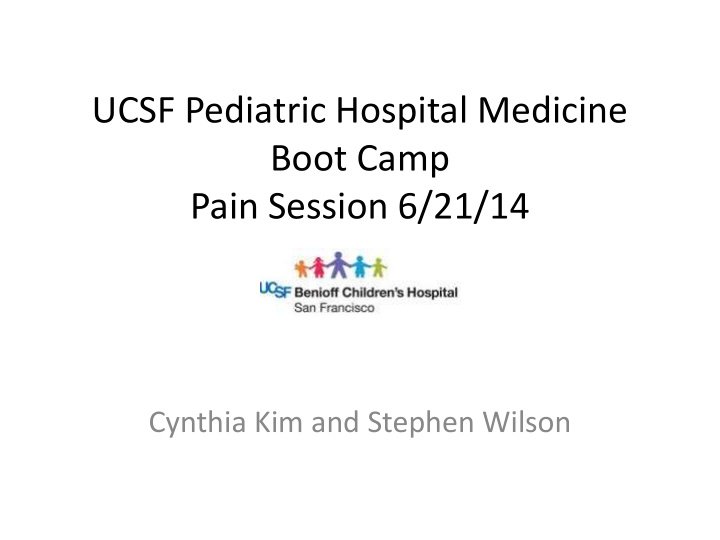



UCSF Pediatric Hospital Medicine Boot Camp Pain Session 6/21/14 Cynthia Kim and Stephen Wilson
Rules • Buzz first and player answers • If answer correct, then the player asks teammates if they want to keep the question • Each player on that team then gives an answer • Each correct answer is worth one point • 3 wrong answers and the other team is up • 3 wrong answers and the slide of answers is shown • Team with most points wins a prize
Question 1: What are adverse side effects of opioids? C
What are adverse side effects of opioids? • Respiratory depression • Somnolence • Dysphoria • Delirium • Nausea/vomiting • Pruritus • Constipation • Myoclonus • Hyperalgesia
Question 2: What can you do to decrease adverse effects of opioids? S
What can you do to decrease adverse effects of opioids? • Decrease drug dose • Increase interval • Change route of administration (po, iv) • Add non-opioid like acetaminophen or ibuprofen • Integrate non-pharm tx (acupuncture, biofeedback) • Encourage exercise • Add low dose naloxone (po, drip) • Opiate rotation (incomplete cross tolerance)
Multimodal approach • Address sleep, anxiety, nausea, spasm, depression Non-opioids • Encourage exercise, massage, biofeedback, acupuncture Adjuvant medications Opioids • Reduce opiate side effects (constipation, itching, nausea, sedation, Integrative and supportive treatments hypventilation
Question 3: What are symptoms of opioid withdrawal? C
What are symptoms of opioid withdrawal? • Abdominal pain • Diarrhea • Nausea/vomiting • Dysphoria, restlessness • Myalgia, arthralgia • Rhinorrhea, lacrimation
Question 4: What secondary symptoms can negatively influence the perception of pain? C
What secondary symptoms can negatively influence the perception of pain? • Sleep • Nausea • Pruritus • Spasm • Anxiety • Depression • Inactivity
Multimodal approach • Address sleep, anxiety, nausea, spasm, depression Non-opioids • Encourage exercise, massage, biofeedback, acupuncture Adjuvant medications Opioids • Reduce opiate side effects (constipation, itching, nausea, sedation, Integrative and supportive treatments hypventilation
Question 5: What are common types of pain? S
Types of pain PAIN NOCICEPTIVE NEUROPATHIC EXPECTED RESULT OF TISSUE PRIMARY LESION OR INJURY DYSFUNCTION IN THE ACUTE TISSUE INJURY OR ACUTE NERVOUS SYSTEM INFLAMMATION PAIN PERSISTS INDEPENDENT NORMAL NEURAL TRANSMISSION OF ONGOING TISSUE INJURY OR INFLAMMATION LOCALIZED CHRONIC, INTRACTABLE PAIN RESOLVES WITH HEALING
Primary Pain Fibers (Nociceptors) • 2 types (slow and fast) – A-delta fibers • Myelinated – Fast • sharp pain – key for precise localization – C-fibers • Unmyelinated - Slow • Burning or aching pain – provides information about severity and ongoing tissue damage
The Nociceptive Pain Pathway
Question 6: What are target receptors for pain medication? (extra credit- different mechanisms) S
Sites to Target • COX-1, 2, 3 • Descending Corticospinal inputs • Opiate (Mu) Receptor • Descending Brainstem • Post-synaptic 5-HT Inputs (nucleus raphe receptor magnus) • NMDA Receptor Alpha- • A-Beta Inputs (Gate 2 Receptor on spinal Control) nociceptors • Cortical Processing • Nerve Membrane (anxiety, coping) • Capsaicin Receptor (TRPV-1)
Question 7: What medications can be used for neuropathic pain? C
What meds can be used for neuropathic pain? • Gabapentin, pregabalin • Conventional anticonvulsants (tegretol, valproate) • Tricyclic antidepressants (amitriptyline) • SNRI (cymbalta) • Methadone
Neuropathic Pain • Caused by injured, altered or dysfunctional hyperexcitability of the peripheral or central nervous system • Typically burning, stabbing, or shooting sensation • Typically persists over a longer period of time • May experience hyperalgesia or allodynia • Meds stabilize neuronal membrane
Question 8: What are some topical anesthetics? S
Local & Topical Anesthetics • EMLA, LMX • Synera • Zingo • Shot Blocker • Lidocaine – Buffer it – Warm it – Use small needle • LET, TAC Zingo Shot Blocker • Vapocoolant sprays
Question 9: What atypical behaviors can children display when in pain? C
Children often display atypical behavioral responses to pain • May become very quiet and still (tuning out the world) • May sleep a lot • May continue to play (self-directed distraction)
Question 10: What are techniques to decrease procedural pain? C
What are techniques to decrease procedural pain? • Swaddling • Parent holding • Pacifier • Sucrose • Topical anesthetics • Preemptive analgesia (acetaminophen)
Question 11: What complementary therapies can be used in pain management? C
What complementary therapies can be used in pain management? • Acupuncture • Biofeedback • Guided imagery • Distraction (bubbles, books, breathing) • Hypnosis • Yoga, meditation • Progressive muscle relaxation • Heat, cold • Prayer
Question 12: Why is codeine not a preferred pain medication? S
Codeine • Weak opiate –ceiling effect due to limited metabolic conversion • Must be metabolized to morphine for analgesic effects • Other metabolites cause nausea, dysphoria • 10% of population CANNOT metabolize – no analgesic effect • 1-2% are ultra-rapid metabolizers – prone to morphine intoxication at normal doses
Ethnic breakdown of Ultra-Rapid Metabolizers of Codeine Per 100 people Caucasians 1-10 African Americans 3 Chinese or Japanese 1 Hispanics 1 North Africans, 16-28 Ethiopians, or Saudi Arabians
Question 13: List 3 medications used for mild, moderate, and severe pain (3 each total to equal 9) (purple card)
Common Post-op Pain Meds UCSF Oral options IV options Step 1 Acetaminophen and/or Ibuprofen Acetaminophen (Ofirmev) (mild pain) Step 2 Tramadol (Ultram) or Ketorolac (Toradol) (moderate pain) Acetaminophen/Hydrocodone (Vicodin, Norco, Lortab, Hycet) Step 3 Oxycodone or Morphine or (severe pain) Acetaminophen/Oxycodone Dilaudid (Percocet, Roxicet)
And the winners are…. Add points and pass out prizes!
Discussion: What lessons in pain management can be applied to Case E patient Sven? C
What lessons in pain management can be applied to Case C patient? • Wean off Oxycontin • Discourage oxycodone • Consider a pain contract • Improve diet • Encourage exercise • Address nausea • Ask about sleep, anxiety, depression • Try more biofeedback or other comp
Acupressure for nausea
Recommend
More recommend